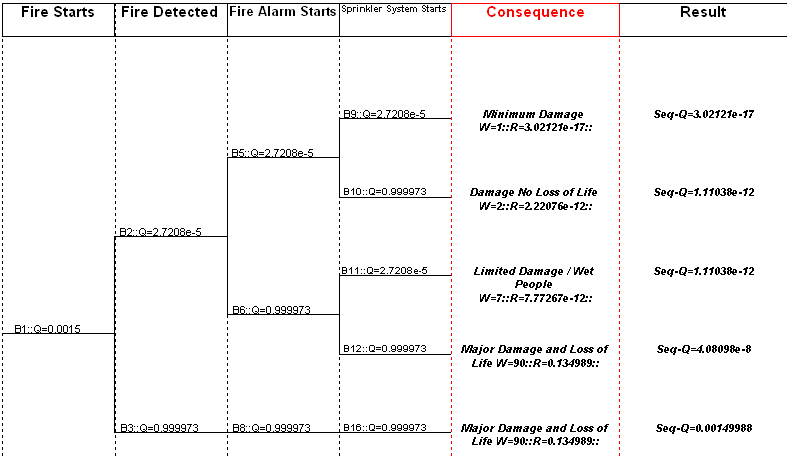Event Tree Analysis
Event tree analysis is based on binary logic, in which an event either has or has not happened or a component has or has not failed. It is valuable in analyzing the consequences arising from a failure or undesired event.
Event tree analysis is generally applicable for almost any type of risk assessment application, but used most effectively to model accidents where multiple safeguards are in place as protective features. Event tree analysis is highly effective in determining how various initiating events can result in accidents of interest.
An event tree begins with an initiating event, such as a component failure, increase in temperature/pressure or a release of a hazardous substance. The consequences of the event are followed through a series of possible paths. Each path is assigned a probability of occurrence and the probability of the various possible outcomes can be calculated.
Event Tree Analysis Characteristics:
- Models the range of possible accidents resulting from an initiating event or category of initiating events
- A risk assessment technique that effectively accounts for timing, dependence, and domino effects among various accident contributors that are cumbersome to model in fault trees
- Performed primarily by an individual working with subject matter experts through interviews and field inspections
- An analysis technique that generates the following:
- Qualitative descriptions of potential problems as combinations of events producing various types of problems (range of outcomes) from initiating events
- Quantitative estimates of event frequencies or likelihoods and relative importance of various failure sequences and contributing events
- Lists of recommendations for reducing risks
- Quantitative evaluations of recommendation effectiveness

Event Tree Analysis Process:
- Define the system or area of interest. Specify and clearly define the boundaries of the system or area for which event tree analyses will be performed.
- Identify the initiating events of interest. Conduct a screening-level risk assessment to identify the events of interest or categories of events that the analysis will address. Categories include such things as groundings, collisions, fires, explosions, and toxic releases.
- Identify lines of assurance and physical phenomena. Identify the various safeguards (lines of assurance) that will help mitigate the consequences of the initiating event. These lines of assurance include both engineered systems and human actions. Also, identify physical phenomena, such as ignition or meteorological conditions that will affect the outcome of the initiating event.
Define accident scenarios. For each initiating event, define the various accident scenarios that can occur.
- Analyze accident sequence outcomes. For each outcome of the event tree, determine the appropriate frequency and consequence that characterize the specific outcome.
- Summarize results. Event tree analysis can generate numerous accident sequences that must be evaluated in the overall analysis. Summarizing the results in a separate table or chart will help organize the data for evaluation.
Use the results in decision-making. Evaluate the recommendations from the analysis and the benefits they are intended to achieve. Benefits can include improved safety and environmental performance, cost savings, or additional output. Determine implementation criteria and plans. The results of the event tree may also provide the basis for decisions about whether to perform additional analysis on a selected subset of accident scenarios.

